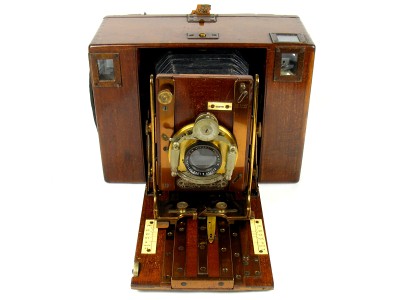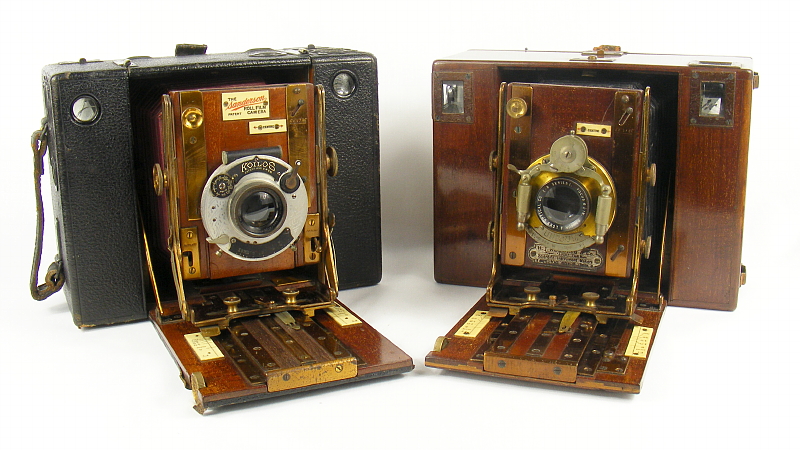Tropical Roll-Film Camera
H. J. Redding & Company
| Plate / Film Size: | 104 film (for pictures 4¾ x 3¾") / 5 x 4 plates |
| Lens: | Bausch & Lomb Series I Rapid Rectlinear F=6½" / f8 |
| Shutter: | B & L Unicum, 1 - 1/100, B, T |
| Movements: | Rising and cross front |
| Dimensions (w x h x l): | |
| Date of this Example: | c1904 |
| Serial Number: | None |
| Availability: |
|
| Inventory Number: | 492 |
|
Photos copyright © 2012 David Purcell. Do not use without permission. |
Description
The Redding Roll-Film camera is a very well made hand & stand camera, which is almost identical in format to a No 4 Cartridge Kodak (both take the same 104 sized film). The Redding camera also shares a number of very strong similarities in its construction with the Roll-Film Sanderson. See Notes below for further details. The two cameras are shown side-by-side in a photograph at the foot of this page.
The camera is designed for dual use - film and plate, with separate distance scales for both on the baseboard.
I believe that the camera is constructed of teak rather than mahogany. It has carefully crafted fine dovetail joints, with brass fittings. As is common in high quality British cameras of this period, the brass screws have the slots in their heads perfectly aligned parallel to the adjacent edge.
The camera carries a name plate below the lens for H. J. Redding & Co (Regd. Luzo Trade Mark) Scientific Instrument Makers 3 Argyll Place, Regent St, London W. Based on evidence from Channing & Dunn [2] plus other cameras seen (including Luzos at Bradford bearing marks for both J Robinson and Redding & Gyles), it appears that this camera dates to sometime between 1900 and 1907. Eric Evans has a well made (unnamed) plate camera bearing exactly the same label.
The camera has black chamfered double extension bellows, with a slight taper and some minor corner damage. Rising and cross front. The baseboard can be dropped to allow the use of a wide angle lens. Dual viewfinder windows (like the Cartridge Kodak), although the seller advised that the right hand window glass had been replaced. It has a sturdy leather handle to one side.
Tripod bushes are located in both sides and the base. The camera came with two numbered DDS and the original ground glass screen (intact). The clip on the baseboard that locks the lens standard has two positions corresponding to correct focus for plate and film. The baseboard also has a fold out brass stand to allow the camera to rest on its side. The baseboard can be dropped to allow use of wide angle lenses.
Notes
A fellow collector has commented on the fact that this camera shows a number of strong similarities in its construction to the Tropical Roll Film Sanderson - refer to the example on the Early Photography web site (last accessed January 2025). I have an example of the leather covered model of the Sanderson Roll Film camera that was constructed for use with the same size of plate and rollfilm (there were three different sizes). The two cameras are shown side by side below. Click on the image to open a larger image and use the Back button to return to this page.
Comparing the two cameras there are a number of obvious similarities not all of which are visible in this photograph.
- The dimensions of the main body are identical (making allowance for leather covering on the Sanderson)
- Ignoring the patented side struts on the Sanderson, the mounting for the lens standard is essentially the same with the same cross-front fixing and lock lever
- The dimensions and construction of the lens board and extension slide are identical
- The lens board itself is identical in size (interchangeable)
- The rising front clamp and lens board retainer are identical
- The film winder key underneath the camera is identical on the two models
- The release locks for the camera back are identical, albeit that the Sanderson has two rather than the single lock found on the Redding camera
There is therefore strong evidence to suggest that the Redding camera was also made by Holmes Brothers, perhaps shortly before they were absorbed into Houghtons Ltd. The Sanderson camera can be dated to 1905, but Holmes Brothers were incorporated into Houghtons in 1904, so I speculate that the Redding camera may date to 1904.
It has been difficult to determine if the Redding camera is made of good quality mahogany or teak. The carcase of the conventional Sanderson Roll Film camera is constructed of mahogany, covered by leather. It weighs approximately 1.8kg, while the Redding camera weighs a little more at 1.9kg. (Note, both are much heavier than the similarly sized No 4 Cartridge Kodak, which weighs in at just 1.4kg). Given that the wood is of fine grain and clearly quite dense, I conclude that the camera is more likely to be made of teak than mahogany. It is therefore reasonable to assume that it was intended for tropical use, like the Tropical Roll Film Sanderson.
I would be very interested to see any advertising material or catalogues relating to the maker or this camera in particular. Please contact me if you have any further information to share.

![[ ]](../../images/unchecked.png)
![[x]](../../images/checked.png)









